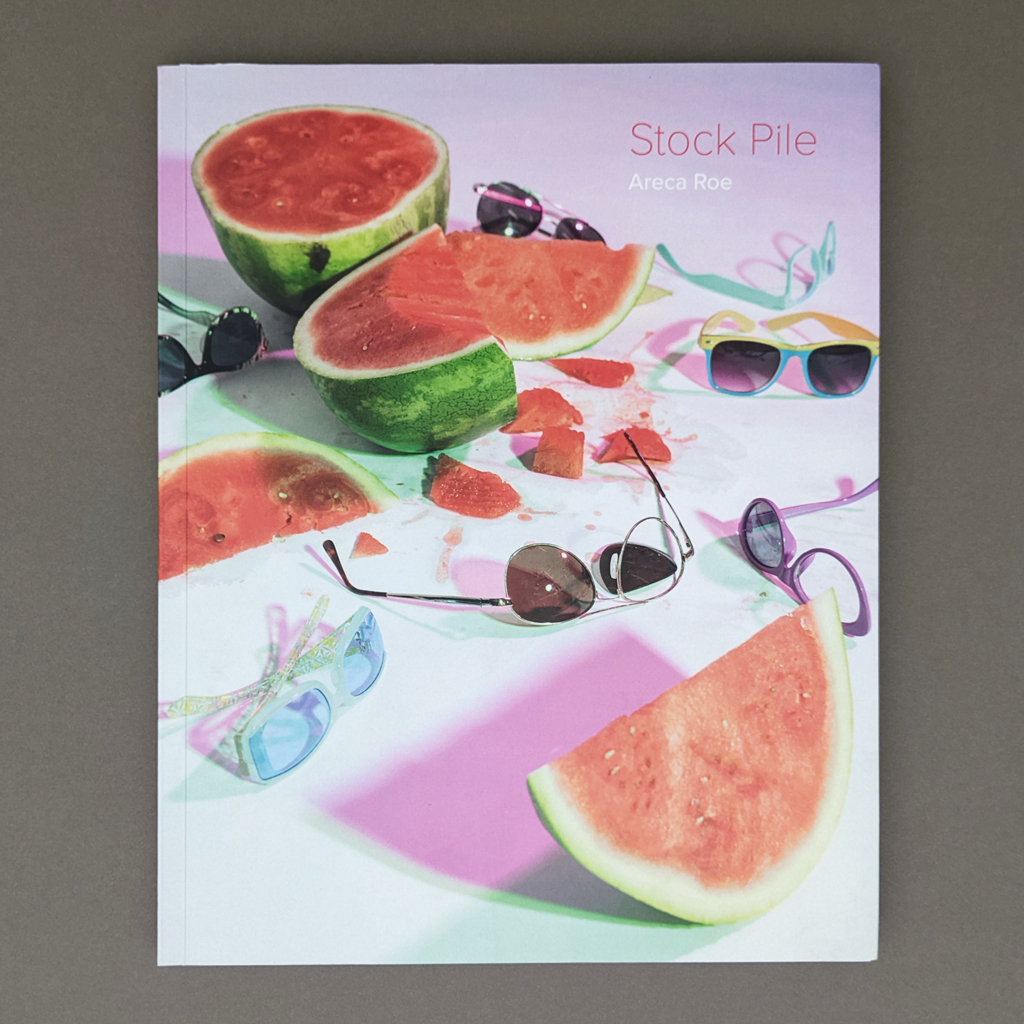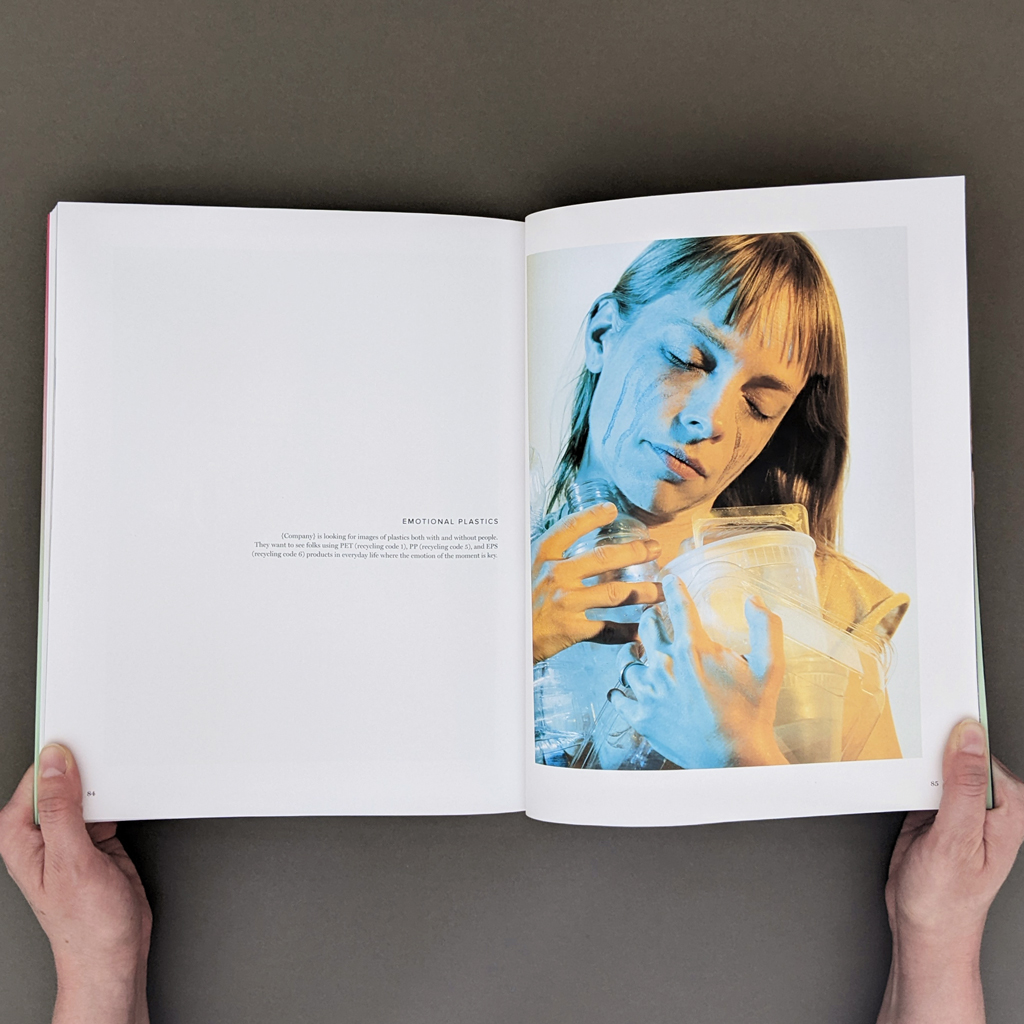Stock Pile
Areca Roe
Design by Kelly Munson
Foreword by Sheila Dickinson
2021
Self-published, printed by Edition One
8.5 × 11 in. closed
90 pages
Perfect-bound softcover with French folds
Laser

Stock photography is an uncanny reflection of reality. Its sanitization and anonymization of familiar settings function as a trick mirror, an almost-real representation that subtly but indelibly differs from what we encounter in everyday life.
Stock Pile serves as a distorted reflection of that distorted reflection, highlighting the surreality of stock photography and more accurately — in an emotional and intellectual sense, if not a physical one — reflecting reality. Areca Roe, a multidisciplinary visual artist and member of TITLE Collective, both satirizes and reinvents the language of stock photo marketplaces and the aesthetic values of the genre.
Her process is relatively simple, but results in a wide variety of works. Each image (a photograph or video still) is based on a prompt from one of three major stock photo marketplaces. Normally, these prompts serve as suggestions for photographers attempting to make and sell stock photos, predictions as to what types of content and style will sell well next quarter. Roe, however, deliberately misinterprets or over-interprets the prompts to create pieces thatsurprise and provoke emotion in a way stock photos rarely, if ever, do. The text of the prompt that inspired the image is included, sometimes helping the viewer to interpret the work and sometimes sharply contrasting with it.
Most images are given an entire page or two-page spread, accompanied only by the brief text of the prompt. Occasionally, multiple images responding to the same prompt share a page. The large size of the images allows the reader to easily take in the finer details, while also imitating the appearance of magazine advertisements or billboards. The size and shape of the book and feel of the paper call to mind both the aforementioned magazines and exhibition catalogs—simultaneously placing stock photography in its expected context and asking us to view it as fine art.

Roe uses herself, her husband, and her children as the models in images containing human figures. While this may have been as much a practical decision as an aesthetic one — much of this work was produced during the height of COVID-19 pandemic restrictions — it also fosters a sense of intimacy and personality. In most stock photography, the artist is totally unknown; credit is usually given to a company rather than the individual or team that actually produced the work. Here, the artist is often quite literally on display.
This is only one of the ways in which Roe skewers stock photography as a quintessential product of late capitalism: a usually meaningless visual produced by someone not paid enough for their labor, most often used as advertising to sell equally meaningless products whose makers were paid even less.

The content of the images pokes fun at the assumptions stock photos have primed the audience to make. In one set of video stills, she presents two well-plated meals exactly like what we would see on a cooking show or Instagram — except that the salad appears to be made mostly of veggie fries and the plate smeared with sriracha and yellow mustard. Another image consists of a woman practicing “self-care,” cucumbers over her eyes and a soothing mask on her face. Reflected in her hand mirror is a burning forest.
While it is perhaps the most obvious interpretation of many of Stock Pile’s images, this satirical impulse does not overshadow the other main thrust of Roe’s work, which is more documentary: an examination of the way people live — and try to live normally — in unsettled times.
An obvious and important inspiration for most of Stock Pile’s images is the ongoing COVID-19 pandemic. In her artist’s statement, Roe indicates she had been interested in making work about or imitating stock photography for some time, but it was in part the pandemic and its associated feelings and changes to daily life that made the project a reality.

The markers of COVID, and particularly those most uncertain and deadly early days of its spread, are everywhere in Stock Pile: face masks, empty shelves, working from home, an attempt to recreate the feeling of a dance club alone in the garage. Roe laments the devastation of the pandemic and laughs bitterly at the “solutions” advertisers offer, but also displays the more mundane feelings isolation produces: boredom, the awkwardness of masks and at-home haircuts, a longing for the familiar structure of the day.
Tackling multiple subjects from multiple angles means the tone of the images varies greatly. In some works, this might be seen as a flaw, muddying the proverbial waters, but with regard to both stock photography and the experience of the pandemic, this nuance and willingness to hold different, sometimes contradictory feelings enhance the work.
The wide variety of images, which jump from one tone or subject to another, mirrors the often jarring, sometimes amusing juxtapositions of radically different images in everyday media. In addition to the COVID throughline and reappearing models, this seeming disunity actually ties these images into a cohesive whole. When Roe follows an image of “the sublime” with a “fantasy, botanical, Nordic noir” book cover and a “subtle image of consumers wearing floral,” the experience is not unlike a serious piece of journalism being interrupted by a pet food ad, followed by one for a new antidepressant — except that Stock Pile’s version is a bit more fun.

Because of its sheer ubiquity, stock photography creates reality as much as reflects it, allowing large companies to not only appeal to the way we live, but in some small way to shape it, repeatedly exposing us to their idea of normal: an idea driven more by profit and assumptions than reality or need. Stock Pile’s emotional variety and focus on surprise and humor contradict and counteract what Roe terms the genre’s “bland cheeriness” in her project statement.
Instead of the calculated invisibility and inoffensiveness that seems the goal of much stock photography, Roe offers up a personal, messy look at human emotions and experiences. There are terrible moments and wonderful ones, and many shaded with both. Rejecting a normative, capitalistic view of the world, Stock Pile reminds the viewer not to forget the sometimes simultaneous beauty and absurdity of messy, contradictory life.

Leave a comment